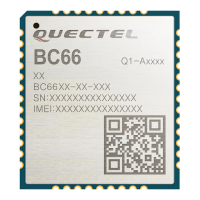NB-IoT Module Series
BC66 Hardware Design
BC66_Hardware_Design 19 / 59
Table 6: Modem Operating Modes
Table 7: Module Operating Modes
3.5. Deep Sleep
Based on system performance, the module consumes an ultra-low current (typically 3.5μA current
consumption) in Deep Sleep mode. Deep sleep mode is designed to reduce power consumption of the
module and improve battery life. The following figure shows the power consumption of the module
(modem) in different modes.
Network-registered. The network is connected and the module supports data
transmission. In such a case, the modem can switch to DRX/eDRX mode.
Network-registered. The modem is in idle mode, and downlink data can be received
during PTW only. In such a case, the modem can switch to PSM or connected mode.
Network-registered. In PSM, the modem is disconnected from the network and cannot
receive any downlink data. In such a case, the modem can switch to connected mode.
When the AP is in normal mode or the modem is connected mode, the module will be
active and supports all services and functions.
The current consumption in active mode is higher than sleep modes.
When the AP is in idle mode and the modem is in DRX/eDRX mode, the module will
enter Light Sleep mode. In such a case, the AP tasks will be suspended and the
modem receives downlink data only during PTW.
In Light Sleep mode, the current consumption of module is reduced greatly.
When the AP is in idle mode and the modem is in PSM, the module will enter Deep
Sleep mode in which the CPU is powered off and only the 32kHz RTC clock is working.
In Deep Sleep mode, the current consumption will be reduced to the minimum
(typically 3.5μA).

